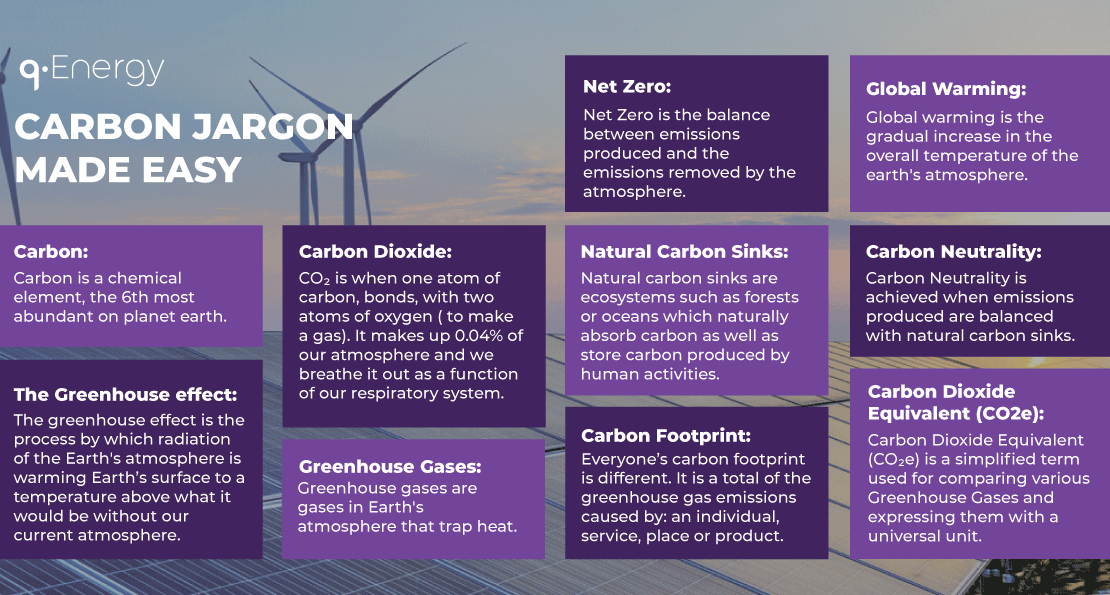Ever felt overwhelmed by all the jargon that comes with the word carbon. Well, worry no more, because this blog provides simplified definitions so carbon jargon confusion will be a thing of the past.
Carbon Jargon Made Easy

Carbon:
Carbon is a chemical element, the 6th most abundant on planet earth. Carbon on its own isn’t the issue in regards to Climate Change, it is in fact Carbon Dioxide(CO₂).
Carbon Dioxide:
CO₂ is when one atom of carbon, bonds with two atoms of oxygen (to make a gas). It makes up 0.04% of our atmosphere and we breathe it out as a function of our respiratory system.
CO₂ acts as a blanket which traps heat helping to keep the earth warm for us humans to survive. Due to deforestation and increased carbon dioxide emissions we are causing the carbon balance to be disrupted. So much so, the earth’s blanket is getting thicker and thus the earth is getting warmer. This is what we mean when we refer to global warming.
Global Warming:
Global warming is the gradual increase in the overall temperature of the earth’s atmosphere. It is generally attributed to the greenhouse effect caused by increased levels of CO₂.
The Greenhouse effect:
The greenhouse effect is the process by which radiation of the Earth’s atmosphere is warming Earth’s surface to a temperature above what it would be without our current atmosphere.
Climate Change:
Climate Change includes both global warming driven by human emissions of greenhouse gases and the resulting large-scale shifts in weather patterns.
Greenhouse Gases:
Greenhouse gases are gases in Earth’s atmosphere that trap heat. They let sunlight pass through the atmosphere, but they prevent the heat that the sunlight brings from leaving the atmosphere. CO₂ isn’t the only gas that has this ‘greenhouse effect’ – there are a few other gases too – the main ones being water vapour, methane (CH4), nitrous oxide (N2O) and ozone.
Like CO₂ we are releasing many of these into the Earth’s atmosphere at a rapid rate.
Carbon Footprint/ Emissions:
Everyone’s carbon footprint is different. It is a total of the greenhouse gas emissions caused by: an individual, service, place, product.
Carbon Dioxide Equivalent (CO2e):
Carbon Dioxide Equivalent (CO₂e) is a simplified term used for comparing various Greenhouse Gases and expressing them with a universal unit.
Each Greenhouse gas has a different period of time that it stays in the atmosphere for, as well as, how much heat they absorb. Thus, each Greenhouse gas has a different impact on the Earth’s atmosphere. But, to make it easier each Greenhouse gas is converted to how much CO₂ it would generate. This makes it easier to comprehend each Greenhouse gases relative impact.
Lets say 1kg of Methane had a 25x greater impact on global warming than 1kg of CO₂ over 100 years (1*25). This means methane’s CO₂e would be 25kg.
Net-Zero:
Net-zero is the balance between emissions produced and the emissions removed by the atmosphere.
Net-zero is in fact, the most well-known term used when discussing Climate Change strategies. The UK government has pledged to achieve net-zero by 2050.
Carbon Positive and Carbon Negative:
They both warrant the same outcome. Both carbon positive and negative means that more carbon is removed from the atmosphere than added. This is the next step after net-zero.
Carbon Neutrality:
Carbon Neutrality is achieved when emissions produced are balanced with natural carbon sinks.
Natural Carbon Sinks:
Natural carbon sinks are ecosystems such as forests or oceans which naturally absorb carbon as well as store carbon produced by human activities.
As it stands natural carbon sinks are absorbing approximately 50% of human produced carbon due to deforestation and increased emissions hence hence the drive towards net-zero.
Carbon Credits:
Carbon credits is a cap-and-trade currency. Big corporations start with a number of credits and are limited to how much they can pollute up to. If a business has unused credits they can sell them to another company that is exceeding their carbon limit.
It was introduced to push companies that excessively pollute to reduce their emissions and pollution.
